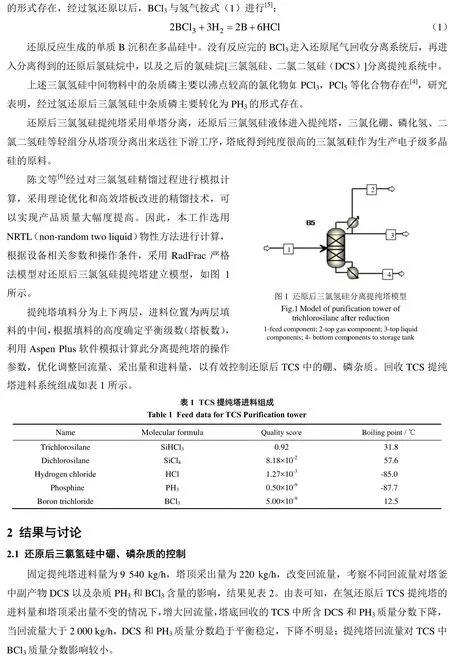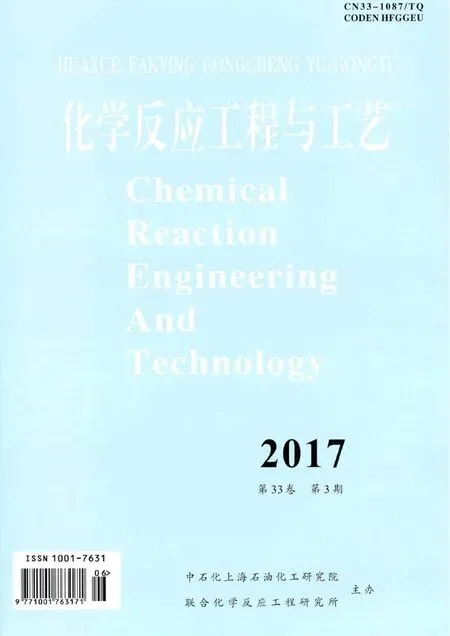氢还原后三氯氢硅的杂质控制
杨丞杰,宋东明
1.昆明冶研新材料股份有限公司,云南 曲靖 655000
2.云南省光电子硅材料制备技术企业重点实验室,云南 曲靖 655000
氢还原后三氯氢硅的杂质控制
杨丞杰1,2,宋东明1,2
1.昆明冶研新材料股份有限公司,云南 曲靖 655000
2.云南省光电子硅材料制备技术企业重点实验室,云南 曲靖 655000



表2 调整回流量塔釜TCS中副产物及杂质含量Table 2 The by-product and impurity content in the tower kettle TCS after adjustment of the reflux quantity
固定提纯塔进料量为9 540 kg/h,塔顶采出量为600 kg/h,考察不同回流量对塔釜中副产物DCS以及杂质PH3和BCl3含量的影响,结果见表3。由表可知,当提纯塔进料量不变,增加塔顶采出量,对比表2的计算结果,对降低氢还原后回收的TCS中PH3,BCl3和DCS含量有相似的结论。在相同回流量,塔顶采出量增加的情况下,氢还原后TCS中副产物DCS含量变化不大,但杂质PH3,BCl3含量明显降低。

表3 调整回流量塔釜TCS中副产物及杂质含量Table 3 The by-product and impurity content in the tower kettle TCS after adjustment of the reflux quantity
固定回流量为3 500 kg/h,塔顶采出量为600 kg/h,考察进料量对塔釜中副产物DCS以及杂质PH3和BCl3的影响,结果见表4。由表可知,随着提纯塔进料量的降低,塔釜回收的还原后TCS中的DCS、PH3和BCl3明显下降。

表4 进料量对塔釜TCS中副产物及杂质含量的影响Table 4 The by-product impurity content in the tower kettle TCS after adjustment of the feed flow
2.2 还原后TCS中碳杂质的控制
还原后 TCS中碳杂质主要是由于石墨夹头和电极四氟垫片在高温下挥发进入还原炉,与还原炉中大量的氢气反应生成 CH4[7]和甲基氯硅烷[8],CH4进入尾气回收系统后,存在于回收氢气中无法分离出来,而甲基氯硅烷则进入还原后的氯硅烷,最后再次进入还原炉,并沉积在硅棒上。为控制回收氢气和还原后TCS中杂质碳的含量,采取一些措施:(1)将石墨夹头在1 200 ℃下进行煅烧,除去里面残留的水分和灰分;(2)当还原炉运行一个周期后,石墨夹头表面一般沉积一层致密的多晶硅,经过工艺和石墨夹头结构调整,将石墨夹头回收使用,可以减少碳杂质的带入;(3)将还原电极用四氟垫片改为金属石墨缠绕垫片,避免四氟材质在高温下融化挥发进入还原炉。
2.3 还原后TCS中金属杂质的控制
多晶硅还原系统带入的金属杂质主要来自于还原炉钟罩和电极基盘,在还原炉停炉倒棒,钟罩清洗和基盘擦拭过程都将会带入金属杂质。在操作中主要采取以下措施来减少金属杂质的带入:(1)减少还原炉停炉倒棒率。通过不同的硅棒形态研究不同的还原炉倒棒率,将还原倒棒率降低15%,硅棒表面金属杂质大幅度下降,进而也避免了金属杂质进入还原后氯硅烷系统。生产中每月产品表面金属杂质含量明显下降,如图2所示。

图2 硅棒表面金属含量趋势Fig.2 Trend of the metal content on surface of silicon rod

图3 还原炉钟罩内壁抛光处理效果Fig.3 The inner surface of bell jar after polishing and chemical vapor deposition
(2)对还原炉钟罩进行机械打磨抛光,然后经过酸洗钝化,对钟罩内部进行电化学镀膜处理,如图3所示,增加钟罩的光洁度和清洗后的洁净度。
(3)在清洗钟罩、基盘的过程中,严禁使用钢丝球、水砂纸,清洗液使用脱盐水或超纯水,避免带入金属杂质。
3 结 论
a)生产高品质多晶硅所需要的氢还原后三氯氢硅,可通过对其提纯塔的模拟计算分析,获得优化操作工艺,能有效控制其中杂质含量。采用Aspen Plus模拟软件对还原后三氯氢硅提纯塔进行模拟计算,当提纯塔进料量、回流量和塔顶采出量分别为6 000,3 500,600 kg/h时,可有效降低氢还原后三氯氢硅中DCS,PH3和BCl3的含量;
b)还原炉电极垫片使用金属缠绕垫和经过高温煅烧的回收石墨夹头,能减少碳元素对多晶硅的污染;对还原炉钟罩进行抛光处理,降低倒棒率,能降低多晶硅产品中金属杂质含量。
[1]黄小明, 杨光美. 高纯TCS生产中硼磷杂质的去除 [J]. 化工生产与技术, 2012, 19(5):55-56, 64.Huang Xiaoming, Yang Guangmei. Remove the B and P impurities in the high purity TCS [J]. Chemical Production and Technology,2012, 19(5):55-56, 64.
[2]李群生, 张满霞, 白 洁, 等. 三氯氢硅精馏过程的计算机模拟及优化设计[C]//北京化工大学学报(自然学科版). 北京: 京台化学工程与技术学术研讨会, 2011: 18-23.
[3]王宝华. 三氯氢硅精馏过程的模拟与优化 [J]. 北京化工大学学报: 自然科学版, 2012, 39(1):1-5.Wang Baohua. Simulation and optimization of trichlorosilane distillation process [J]. Journal of Beijing University of Chemical Technology: Natural Science Edition, 2012, 39(1):1-5.
[4]江庆云. 改良西门子法生产多晶硅中反应精馏除硼的模拟研究 [J]. 中国化工贸易, 2015, 7(26):10-15.Jiang Qingyun. Simulation study on boron removal by reactive distillation in polysilicon production by modified SIEMENS process [J].China Chemical Trade, 2015, 7(26):10-15.
[5]王作民. 超纯硅制备工艺中杂质行为的探讨 [J]. 上海有色金属, 1983, 4(2):58-65.Wang Zuomin. Discuss of impurities in the preparation of high purity silicon [J]. Shanghai Metal, 1983, 4(2):58-65.
[6]陈 文, 徐 昱, 陈卫强, 等. 三氯氢硅精馏新过程的研究及其节能降耗的应用 [J]. 化工进展, 2009, 28(S2):297-300.Chen Wen, Xu Yu, Chen Weiqiang, et al The application of new energy saving process of trichlorosilane distillation [J]. Chemical Progress, 2009, 28(S2):297-300.
[7]杨 晟. 关于多晶硅生产中碳元素形成的研究 [C]// 多晶硅及太阳能电池技术发展研讨会论文集. 西安: 多晶硅及太阳能电池技术发展研讨会, 2011:253-258.
[8]蔡延国, 魏东亮, 祝永强, 等. 多晶硅碳含量对产品质量的影响及处理工艺 [J]. 化学反应工程与工艺, 2016, 32(4):373-377.Cai Yanguo, Wei Dongliang, Zhu Yongqiang, et al. Effects of carbon content on quality of polysilicon products and treatment process [J].Chemical Reaction Engineering and Technology, 2016, 32(4):373-377.
Impurity Control of Trichlorosilane after Hydrogen Reduction
Yang Chengjie1,2, Song Dongming1,2
1. Kunming Yeyan New-Material Company Limited, Qujing 655000, China;2. Key Lab of Yunnan Province Optoelectronic Silicon Materials Preparation Technology Enterprises, Qujing 655000, China
In order to control the content of impurity in trichlorosilane after reduction, simulation calculations of trichlorosilane purification tower was carried out by Aspen Plus simulation software. The effects of the feed, back flow and recovery amount on the boron and phosphorus impurities in the trichlorosilane were investigated. The control measures of carbon and metal impurities in trichlorosilane after reduction were explored in the practical production. The results showed that the content of boron and phosphorus impurities in trichlorosilane can be reduced effectively after reduction of trichlorosilane by reducing the feed amount, improving the recovery and back flow rate in the purifying tower. Effectively control of the impurity content of carbon and metal after hydrogen reduction in trichlorosilane can also be made by reasonable maintenance and selection of reduction furnace bell jar, base plate and spare parts.
silicon reduction; trichlorosilane; impurities control
1001—7631 ( 2017 ) 03—0284—05
10.11730/j.issn.1001-7631.2017.03.0284.05

